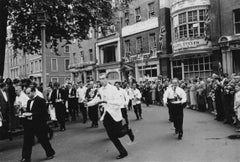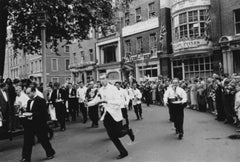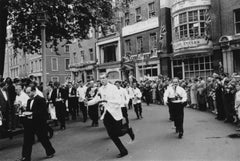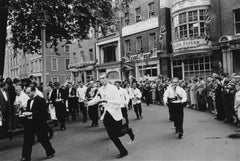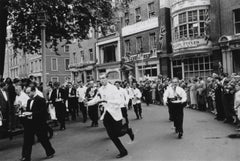Waiters Race
1950s Modern Black and White Photography
Silver Gelatin
1950s Modern Black and White Photography
Silver Gelatin
1950s Modern Black and White Photography
Silver Gelatin
1950s Modern Black and White Photography
Silver Gelatin
1950s Modern Black and White Photography
Black and White, Silver Gelatin
1950s Modern Black and White Photography
Silver Gelatin
1950s Modern Black and White Photography
Silver Gelatin
1950s Modern Black and White Photography
Silver Gelatin
1950s Modern Black and White Photography
Silver Gelatin
1950s Modern Portrait Photography
Black and White, Silver Gelatin
1950s Modern Black and White Photography
Silver Gelatin
1950s Modern Black and White Photography
Silver Gelatin
1950s Modern Black and White Photography
Silver Gelatin
1950s Modern Portrait Photography
Black and White, Silver Gelatin
1950s Modern Black and White Photography
Silver Gelatin
1950s Modern Black and White Photography
Silver Gelatin
Recent Sales
1950s Modern Black and White Photography
Silver Gelatin
1950s Modern Black and White Photography
Silver Gelatin
1950s Modern Black and White Photography
Silver Gelatin
1950s Modern Black and White Photography
Silver Gelatin
1950s Modern Portrait Photography
Black and White, Silver Gelatin
People Also Browsed
2010s Italian Modern Architectural Elements
Steel
21st Century and Contemporary Brazilian Modern Armchairs
Bouclé
1960s Modern Landscape Photography
Archival Pigment
2010s Slipper Chairs
Velvet
Vintage 1960s Polish Industrial Wall Lights and Sconces
Steel
2010s American Mid-Century Modern Wall Lights and Sconces
Brass, Bronze, Enamel, Nickel
2010s Chinese Books
Paper
Early 2000s American Mid-Century Modern Books
Paper
2010s American Other Coffee and Cocktail Tables
Lacquer
1970s Modern Color Photography
C Print
2010s Contemporary Nude Photography
Archival Pigment, Rag Paper
2010s Vietnamese Dressers
Oak
Antique 1880s British Victorian Sofas
Brass
Antique 19th Century Irish Armchairs
Upholstery, Yew
21st Century and Contemporary Books
Paper
2010s Contemporary Nude Photography
Archival Pigment, Rag Paper
Waiters Race For Sale on 1stDibs
How Much is a Waiters Race?
Slim Aarons for sale on 1stDibs
American photographer Slim Aarons captured the 20th century’s international jet set — U.S. socialites, European royalty, Hollywood stars — at play in sun-kissed locales like Monaco, Saint-Tropez and Palm Beach, as well as other luxurious settings around the globe.
Committed to eschewing makeup and artificial lighting, Aarons created images that are at once candid and polished, combining the relaxed posture of his subjects, who trusted him to document their lives, with the visual sharpness of a seasoned art director. Having gotten his start taking pictures for the U.S. military magazine Yank during World War II, he contributed over the course of his career to Life, Town and Country and Holiday magazines and published several books.
Aarons was born in Manhattan in 1916. He joined the army at 18, shooting military maneuvers at West Point before serving as a combat photographer, for which he was awarded a Purple Heart. After the war, he moved to California and began snapping socialites and movie stars.
In the 1950s, Aarons opened a bureau for Life magazine in Rome, where he took pictures capturing the postwar scene. He was always able to win the trust of his elite subjects, who saw him as close to a peer, rather than a paparazzo.
In a 2002 interview with The Independent, Aarons remarked, ''I knew everyone. They would invite me to one of their parties because they knew I wouldn't hurt them. I was one of them.'' This access allowed him to document the rich and famous with their guard down, reading newspapers and magazines, talking on the phone, relaxing by the pool, and chatting with friends. The 1957 photograph The Kings of Hollywood, for example, which won him wide acclaim, shows Clark Gable, Van Heflin, Gary Cooper and Jimmy Stewart laughing together as they celebrate New Year’s Eve.
Many of Aarons’s best-known images involve games and sports. In the 1972 Poolside Backgammon, two young women play the board game of the title against the backdrop of a majestic Acapulco estate. In 1958’s Cannes Watersports, a couple attempts to glide across the Golfe de la Napoule on Jet Skis, one expertly and one hanging on for dear life. And in Penthouse Pool, shot in Athens in 1961, a young woman wearing a yellow bathing cap smiles coyly at the camera, surrounded by friends and brightly colored seat cushions, with the Acropolis faintly visible in the background.
Among Aarons’s books are 1974’s A Wonderful Time: An Intimate Portrait of the Good Life, and its 2003 sequel, Once Upon a Time. His final book, A Place in the Sun, was published in 2005, one year before his death.
Find a collection of vintage Slim Aarons photography on 1stDibs.
A Close Look at Modern Art
The first decades of the 20th century were a period of artistic upheaval, with modern art movements including Cubism, Surrealism, Futurism and Dadaism questioning centuries of traditional views of what art should be. Using abstraction, experimental forms and interdisciplinary techniques, painters, sculptors, photographers, printmakers and performance artists all pushed the boundaries of creative expression.
Major exhibitions, like the 1913 Armory Show in New York City — also known as the “International Exhibition of Modern Art,” in which works like the radically angular Nude Descending a Staircase by Marcel Duchamp caused a sensation — challenged the perspective of viewers and critics and heralded the arrival of modern art in the United States. But the movement’s revolutionary spirit took shape in the 19th century.
The Industrial Revolution, which ushered in new technology and cultural conditions across the world, transformed art from something mostly commissioned by the wealthy or the church to work that responded to personal experiences. The Impressionist style emerged in 1860s France with artists like Claude Monet, Paul Cézanne and Edgar Degas quickly painting works that captured moments of light and urban life. Around the same time in England, the Pre-Raphaelites, like Edward Burne-Jones and Dante Gabriel Rossetti, borrowed from late medieval and early Renaissance art to imbue their art with symbolism and modern ideas of beauty.
Emerging from this disruption of the artistic status quo, modern art went further in rejecting conventions and embracing innovation. The bold legacy of leading modern artists Georges Braque, Pablo Picasso, Frida Kahlo, Salvador Dalí, Henri Matisse, Joan Miró, Marc Chagall, Piet Mondrian and many others continues to inform visual culture today.
Find a collection of modern paintings, sculptures, prints and other fine art on 1stDibs.
Finding the Right Black-white-photography for You
There’s a lot to love about black and white photography.
The unique and timeless quality of a black and white photograph accentuates any room. Some might argue that we’re naturally drawn to color photography because it’s the world we know best. This is a shared belief, particularly in the era of camera-phone photography, editing apps and the frenetic immediacy of sharing photos on social media. But when we look at black and white photography, we experience deep, rich shadows and tonal properties in a way that transfixes us. Composition and textures are crisp and engaging. We’re immediately drawn to the subjects of vintage street photography and continue to feel the emotional impact of decades-old photojournalism. The silhouettes of mountains in black and white landscape photography are particularly pronounced, while portrait photography and the skylines of urban cityscapes come to life in monochrome prints.
When decorating with fine photography, keep in mind that some color photographs may not be suitable for every space. However, you can be more daring with black and white photos. The gray tones are classic, sophisticated and generally introduce elegance to any corner of your home, which renders black and white prints amazingly versatile.
Black and white photography adapts to its surroundings like a chameleon might. A single large-scale black and white photograph above the sofa in your living room is going to work with any furniture style, and as some homeowners and designers today are working to introduce more muted tones and neutral palettes to dining rooms and bedrooms, the integration of black and white photography — a hallmark of minimalist decor — is a particularly natural choice for such a setting.
Another advantage to bringing black and white photography into your home is that you can style walls and add depth and character without worrying about disrupting an existing color scheme. Black and white photographs actually harmonize well with accent colors such as yellow, red and green. Your provocative Memphis Group lighting and bold Pierre Paulin seating will pair nicely with the black and white fine nude photography you’ve curated over the years.
Black and white photography also complements a variety of other art. Black and white photos pair well with drawings and etchings in monochromatic hues. They can also form part of specific color schemes. For example, you can place black and white prints in colored picture frames for a pop of color. And while there are no hard and fast rules, it’s best to keep black and white prints separate from color photographs. Color prints stand out in a room more than black and white prints do. Pairing them may detract attention from your black and white photography. Instead, dedicate separate walls or spaces to each.
Once you’ve selected the photography that best fits your space, you’ll need to decide how to hang the images. If you want to hang multiple photos, it’s essential to know how to arrange wall art. A proper arrangement can significantly enhance a living space.
On 1stDibs, explore a vast collection of compelling black and white photography by artists such as Mark Shaw, Jack Mitchell (a photographer you should know), Berenice Abbott and David Yarrow.
- 1stDibs ExpertNovember 20, 2024Slim Aarons's real name was George Allen Aarons, and his nickname came from the fact that he was tall and slender. An American photographer, Aarons captured the 20th century’s international jet set — U.S. socialites, European royalty and Hollywood stars — at play in sun-kissed locales like Monaco, Saint-Tropez and Palm Beach. Committed to eschewing makeup and artificial lighting, Aarons created images that are at once candid and polished, combining the relaxed posture of his subjects, who trusted him to document their lives, with the visual sharpness of a seasoned art director. Having gotten his start taking pictures for the U.S. military magazine Yank during World War II, he contributed over the course of his career to Life, Town and Country and Holiday magazines and published several books. Find a selection of Slim Aarons photography on 1stDibs.
